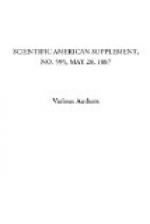That the excessively low refractive power of tabasheer is connected with the mechanical admixture of the colloidal silica with air seems to be proved by the experiments of Brewster, showing that with increase of density there was an increase in the refractive index from 1.111 in specimens of the lowest specific gravity to 1.182 in those of the highest specific gravity. Where the surface was hard and dense, Brewster found the refractive index to approach that of semi opal. The wonderful thing is that a substance so full of cavities containing gas should nevertheless be transparent.
By the kindness of Mr. F. Rutley, F.G.S., I am able to supply a drawing taken from one of my sections of tabasheer.
The accompanying woodcut gives some idea of the interesting structures exhibited in some sections of tabasheer, though much of the delicacy and fidelity of the original drawing has been lost in transferring it to the wood.
In this particular case, the faint punctation of the surface may possibly indicate the presence of air vesicles of a size sufficiently great to be visible under the microscope. But in many other instances I have failed to detect any such indication, even with much higher powers. The small ramifying tubules might at first sight be taken for some traces of a vegetable tissue, but my colleague, Dr. Scott, assures me that they do not in the least resemble any tissue found in the bamboo. I have myself no doubt that it is an inorganic structure. It is not improbably analogous to the peculiar ramifying tubules formed in a solution of water glass when a crystal of copper sulphate is suspended in it, as shown by Dr. Heaton (Proc. Brit. Assoc., 1869, p. 127). Similar forms also occur on a larger scale in some agates, and the artificial cells of Traube may probably be regarded as analogous phenomena.
The aggregates of globular bodies seen in the section so greatly resemble the globulites of slags and natural glasses, and in their arrangement so forcibly recall the structures seen in the well known pitchstone of Corriegills in Arran, that one is tempted to regard them as indicating the beginnings of the development of crystalline structure in the tabasheer. But I have good grounds for believing the structure to have a totally different origin. They seem in fact to be the portions of the mass which the fluid Canada balsam has not succeeded in penetrating. By heating they may be made to grow outward, and as more balsam is imbibed they gradually diminish, and finally disappear.
I must postpone till a future occasion a discussion of all the structures of this remarkable substance and of the resemblances and differences which they present to the mineral opals on the one hand, and to those of the opals of animal origin found in sponge spicules, radiolarians, and the rocks formed from them, some of which have recently been admirably investigated by Dr. G.J. Hinde (Phil. Trans., 1885, pp. 425-83).




